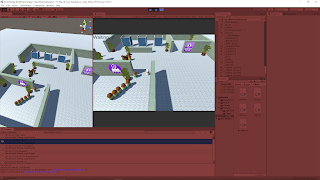July 30, 2020
AI For Beginners
Goal Orientated Action Planning (GOAP)
Parts 9 and 10
Beginner Programming: Unity Game Dev Courses
Unity Learn Course – AI For Beginners
Creating a Multi-Step Plan
Creating a Multi-Step Plan
This tutorial begins linking multiple actions together to create more intricate action plans. To do so, they created a second GAction, GoToWaitingRoom. GoToHospital action was given an after effect of hasArrived and GoToWaitingRoom was given a precondition of hasArrived to give them a point to link together. GoToWaitingRoom was then given the after effect isWaiting, so that the goal given would match up with this second action’s outcome. This let’s the system take an input goal of isWaiting and deduce the plan of action to get there through these two actions.
Just to better visualize this demonstration, they created a basic spawner to consistently spawn in new patients to show that the newly created objects can follow the plans created properly as well.
Plans that Require Multiple Agents
Plans that Require Multiple Agents
I immediately had issues with this tutorial because they give a couple scripts directly to you for use in these next steps and they had compile errors in them that stopped me from progressing. These are the GAgentVisual and GAgentEditor classes. One of the first steps requires you to add the GAgentVisual component to the Patient game objects but I could not because of errors in the GAgentEditor class.
The issue was that it did not recognize the lists of preconditions and after effects within the GActions as KeyValuePairs. To resolve this, I modified them to go through the lists as WorldStates and just use those key values instead of the very direct Key values of a KeyValuePair. This at least removed the compile errors initially so I could progress.
This visualizer however is a nice addition. It lays out the individual agent’s plan as well as the preconditions and after effects throughout the process to help the designer keep track of what is going on behind the scenes. This is just generally helpful as well as a useful tool for debugging.
This tutorial begins to work with the nurse agents in the scene. Their first action is GetPatient, but it requires a precondition that is triggered by a change in the world state (beginning the idea of having plans involving multiple types of agents). This is done by adding the following line to the GoToWaitingRoom class:GWorld.Instance.GetWorld().ModifyState(“Waiting”, 1);
To aid the nurses in keeping track of the patients, a queue of gameobjects holding the patient references was added to the overarching GWorld class. This gives a world state parameter to keep track of patients that the nurses can reference.
Getting the world states involved in the planning process has finally necessitated adding some logic to the Preperform and Postperform methods of the GActions. The patients GAction GoToWaitingRoom has a Postperform which informs the world state that more patients are waiting and adds them to the queue, while the nurses have a GAction GetPatient with a Preperform which checks if there are any patients in queue and sets their course for that target only if there is anyone waiting. This also begins the option of having plans “fail” because the goal cannot be met at this time.
Summary
These two tutorials have finally started showing the actual effects of this GOAP system. It shows how creating simple lists of actions can be done easily by the designer, as well as how much easier implementing world state AI is with this system. All of the data is nicely contained and distributed throughout the GActions, the GPlanner, GAgents, and the GWorld. I am excited to see how adding values to the different actions works out and how easily it is implemented on the design side.
